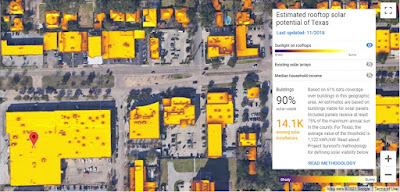Project Sunroof is an initiative launched by Google in 2015 that aims to encourage the adoption of solar energy by providing homeowners with information about the potential for solar power in their area. The project utilizes high-resolution aerial imagery, 3D modeling, and machine learning algorithms to analyze rooftops and estimate their suitability for solar panel installation.
By accessing data such as roof orientation, shade from surrounding structures or trees, and local weather patterns, Project Sunroof generates detailed solar potential maps for different regions. Homeowners can then enter their address into the Project Sunroof website to receive personalized estimates of how much sunlight their roof receives, potential energy savings, and the feasibility of installing solar panels.
The platform also offers additional features, such as cost estimates, information on available solar providers, and financing options. Project Sunroof aims to simplify the process of transitioning to solar energy by empowering homeowners with the knowledge and tools necessary to make informed decisions about solar power installation.
Project Sunroof provides estimated savings based on a variety of factors such as roof area, sunlight exposure, local energy prices, and potential solar system size. However, it's important to understand that these estimates are just that—estimates—and may not reflect the exact savings a homeowner will experience.
Is Project Sunroof's estimated savings accurate?
The accuracy of Project Sunroof's estimated savings depends on the accuracy of the data it uses, such as aerial imagery, 3D modeling, and local energy price information. Google makes efforts to ensure the data is as reliable as possible, but there are limitations and potential inaccuracies inherent in any modeling system.
The estimates provided by Project Sunroof do not take into account factors such as a homeowner's specific energy consumption patterns, changes in energy prices over time, or the potential need for system maintenance or repairs. These factors can influence the actual savings realized from installing solar panels.
Does Project Sunroof factor in fog, clouds, and weather?
Yes, Project Sunroof takes into account weather conditions, including fog, clouds, and local weather patterns, when estimating the solar potential of a rooftop. The project uses historical weather data and local climate information to provide a more accurate assessment of the sunlight exposure a particular area receives.
By analyzing factors like average cloud cover, fog frequency, and local weather patterns, Project Sunroof aims to provide homeowners with a realistic understanding of the solar energy potential in their region. This information is used to estimate the amount of sunlight available for generating solar power and to calculate the potential energy production and savings from installing solar panels.
It's important to note that weather patterns can vary over time, and Project Sunroof's estimates are based on historical data. While the project attempts to provide accurate assessments, there may still be variations due to changes in weather patterns or unforeseen weather events.










